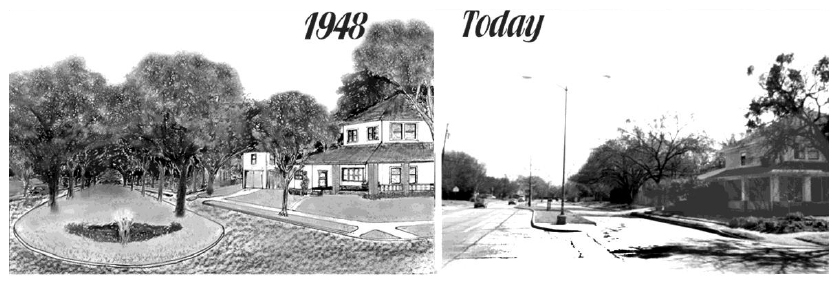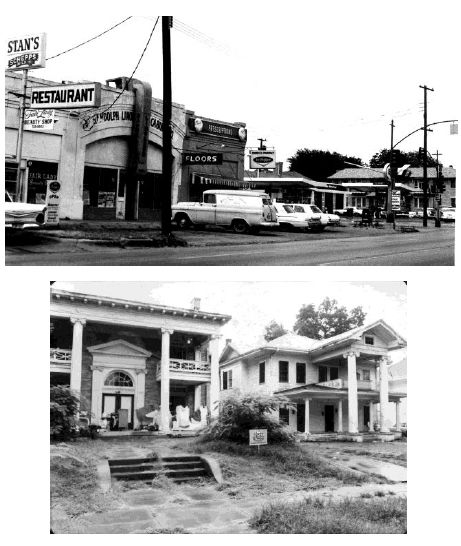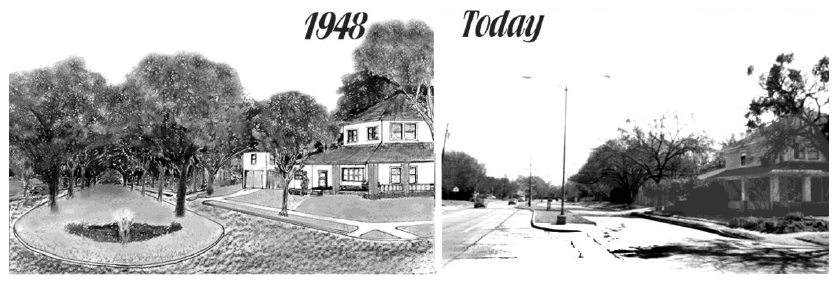…..The twenties were good years for Munger Place. and Dallas. The railroad tracks were removed from Pacific Avenue as Kessler had suggested ten years earlier; a park also proposed by Kessler was planned to be built soon around White Rock Lake. Columbia had grocery stores, pharmacies with soda fountains and Five and Dime stores at the corners at Carroll, Fitzhugh, Columbia and Beacon. The street also had a Mexican Consul, a theater, some cafes, a fire station, streetcar tracks and a Methodist Church, many homes and several large Greek revival houses. All of this in eleven blocks. Things were good until October.
The stock market crash in October 1929 did not hit everyone at once but it lasted for many years and only slowed down some just before the war in December 1941. Munger Place certainly felt the depression. Owners leased rooms to renters and others ran boarding houses in homes that were once elegant. Owners rented the houses out or made them into apartments. As bad as it was, this was not the great decline of Munger Place; that was yet to come in the late fifties and sixties. Wealthy people were hit more than others and times were bad. Eighteen thousand people in Dallas were unemployed. 1933 was the worst year. Dallas had a ‘work for food’ program that helped many. In 1936 Dallas had the Texas Centennial and it was a great boost considering the need for jobs in hard times.
In 1937 the Columbia Theater became the Rita Theater. The tickets were inexpensive and the theater was cool in the summer. It way very helpful for the people in Munger Place in the hard times. Columbia again was helpful to Munger Place and Junius Heights. Roosevelt’s WPA came along in time to give people work to do in enhancing the park at White Rock and other things as well. Munger Place was not as prosperous as it had been but the government was helpful and it was still a good place to live.
In September of 1939 the war in Europe began that soon became World War II. Many people did not want the country to get into the war. But when Pearl Harbor was bombed the whole country was active in helping in the war. Like Winston Churchill said in England,. “This may have been our finest hour.” Most everyone did what they could to do for the country. Even young kids would go down the alleys to pick up any metal to give to the war. The radio and newspapers help to follow the war along with Roy Band’s Barber Shop with his many Life magazines. Most of all, the Columbia Avenue’s Rita Theater had pictures of the war from the newsreels. Many people moved from small towns and farms into Dallas and it was difficult to find places to live.
When the war ended in the fall of 1945, the optimism and elation following the war was amazing. Service men began coming home rapidly with everyone looking forward to a new post war world with all that we had done without for fifteen years during the depression and war. It was a good time for so many men to be free from hard times and home again. Theaters, football, baseball and all places for people to enjoy were filled, packed and congested.
Many said these were the best years and certainly the best years for Columbia between Fitzhugh and Munger Boulevard. Mr. C. V. Carver who owned the Rita Theater moved it to a block on Columbia to make a larger theater called the Avenue because of the large number of customers. Columbia was the Agora of Munger Place for awhile. Carver said he may have made a mistake on overdoing a large theater. In a few years it was true.
By 1950 most of the war veterans were married and settled down. For many they wanted to have a small home in a little community that was a dream long awaited. That what the war had been fought for–to return home, marry the girl next door and live in a Norman Rockwell image of a quiet country town. The war veterans were marrying in great numbers and the birth rate was rising. Many wanted a small home in the suburbs in Garland, Mesquite and Richardson from the east and north side of Dallas.
During the best years many things were happening. that brought a wind of change.
In 1949 television sets came to Dallas and shows and football games could be seen inside the house. The availability of television caused people to spend more time at home and outside entertainment began to slow down. Neighborhood movies and drug stores began to suffer. Many large theaters had few patrons and became bowling allies or the buildings were torn down. The evaporative cooler window fan and later window air conditioner units made homes more comfortable in the long summer months as well as causing homes to be less dusty and easier to clean. Munger Place was a neighborhood of huge two story homes difficult to cool and to clean as well as becoming out of vogue in the new post war America of small suburban houses. One problem for Munger Place and Columbia was Dallas’ total lack of coordinated planning for future problems and the absence of municipal zoning policy until 1927 by city leaders.
After the war East Dallas was zoned for multi-family dwellings to attract developers to build better apartments in place of blocks of small, poorly built frame houses. Many of the small houses were near the Ford plant near East Grand. .Instead, in the mid fifties, the developers overlooked the small houses near East Grand and made more money to raze older but beautiful homes to build large apartments on Gaston and Live Oak; then they set their eyes on Swiss. The so-called ‘garden apartments’ looked impressive and modern but many were poorly built then sold in five years for a good profit before decay set in. In a short time they too looked bad. This also caused the blight that was coming in east Dallas.
Back in 1948 we still had electric transit to Richardson and Plano along Matilda Street north to those outer cities. One could go almost anywhere in Dallas on public transit either by electric streetcar or by bus yet it was to die within a decade. At great expense, we are struggling to regain that today.
The petroleum industry along with the auto and rubber interests, with considerable clout and capital, lobbied the political parties and congressional leaders for favorable legislation to put the automobile forward and to downgrade the transit interests. Transit died in most American cities and the car became a necessity.
Many countries enjoy the freedom of cars but still have public transit. As early as 1936, GM, Firestone and Standard Oil created National City Lines to buy and dismantle streetcar systems in California. By 1955 the whole nation was losing transit systems. In Dallas the transit system was still working but soon it was bought by Henry Weinberg who was known for buying transit systems, destroying them, then selling them to the city and leaving with the profits. Two months after he became chairman of Dallas Transit, Weinberg cut service on 47 Dallas lines, seven percent of all mileage.
What Weinberg had in mind can be inferred, with some hindsight, from what he actually did with three other transit systems-Scranton, Dallas, and New York’s Fifth Avenue Coach Company… In each of these situations, after gaining control he moved on a multi-front blitz to raise profits through higher fares and reduced costs, paring payroll and cutting back on services and siphoning off assets for his personal gain. At the appropriate time, he would either sell what was left of the company to the city for a handsome profit or, as in the case of Scranton, abandon it.
http://www.hawaii.edu/uhwo/clear/Pubs/RutledgeUnionism.htm
Through the decade of the sixties and well into the seventies the decline continued on Columbia Avenue. The Avenue Theater showed X-rated movies and later became a pawn shop. Moore’s Pharmacy became a strip club in the seventies competing with another one at Fitzhugh. It became dangerous to drive through the area.
…..By 1950 some people in Munger Place still lived in a quality house in good repair but the need of apartments blighted the neighborhood and escalated its decline. The move to the suburbs needed more streets for people to drive to town. .By the late fifties as public transit disappeared the need for wider streets to ease congestion rose. What civic leaders did was destroy pleasant drives in Dallas to ease the flow of traffic to the suburbs. Munger Boulevard with its beauty of tree-lined shade on its parkway was wiped out for a six lane thoroughfare.

Munger Place and Swiss Avenue are further converted into apartments. The area began to decline, and property values plummet.
Early 1960s – Residents between the blocks of Fitzhugh and Collett voluntarily remove the neighborhood’s deed restrictions. Deed restrictions between Skillman and La Vista expire shortly thereafter.
Late 1960s – The decay of the neighborhoods reaches a peak, and the area approaches a slum. It’s a haven for motorcycle gangs, drug users, alcoholics, criminals and prostitutes.

In 1964 the City Council had rezoned Swiss Avenue from Fitzhugh to LaVista to be open to developers for apartments. This total disregard for neighborhood attractiveness and sell out to developers must have been so blatant that it caused a backlash. This caused many residents on Swiss to organize. After a long battle the Swiss Avenue residents were able to create a historic district by 1973. They also made loans to some urban pioneers in Munger Place who were fixing up their homes themselves.
In 1969 Harry and Marion Gibson moved to 4949 Worth at Collett. Other urban pioneers saw the opportunity to restore older homes with much more space than average homes. Lakewood Bank made loans available. The Historic Preservation League put together a Historic Dallas fund. Virginia and Lee McAlester with Doug Newby developed a plan for twenty-three properties to be secured. They were resold to individuals and turned back into single-family homes. Harry Gibson recalls Doug Newby often coming to Munger Place riding his bike from SMU without holding the handle bars.
In 1973 there was a gas shortage that increased the price of gas. While that did not scare the public to any great extent, many were tiring of the traffic congestion to the suburbs. Interest in the inner city was developing; this increased with time and was very favorable to Munger Place. Considering the fall of Munger Place this was astonishing .
Many people were instrumental along with the Gibsons, Newby and the McAlesters. Some of these were Suzanne Starling, Ken Gjemre, Paul Crews, Harold and Gail Green and many others within Munger Place. Others included Adlene Harrison on the City Council and Lynn Dunsavage with the Swiss Avenue Historic District. In 1974 the Historic Preservation League (HPL) campaigned and succeeded in saving the Old Lakewood Library. The HPL also published a guide to buying a home in East Dallas, part of a program to interest potential residents in purchasing and preserving homes in the inner city.
By 1978 the Munger Renaissance was in full swing. Things had been improving since 1973 when Fred Longmore saw a bulldozer bearing down on one of the Junius Heights columns around the 5800 block of Tremont. The tall columns that were built around 1917 were an East Dallas landmark. Fred jumped out of his car and asked the operator what he was doing. He was told the columns were too costly to be removed piece by piece and were in the way of the new Columbia-Abrams connection.

The Junius Heights Columns before they were saved and moved.
A wrought iron arch once joined the columns together but was removed as it deteriorated.
Fred was able to halt the construction until help came from the East Dallas Community Design Committee and the Historic Preservation League. The columns were saved and moved a short distance to allow the path of the new thoroughfare. This was a real turnaround in Dallas where preservation usually lost in similar situations.
In 1980, area residents persuaded the city of Dallas to create the Munger Place Historic District. The Historic District is now recognized by the United States National Register of Historic Places and represents over 250 households as the largest collection of Prairie-Style homes in America.
While Munger Place was restored; Columbia Avenue was not. Once Columbia Avenue provided for so long a community marketplace that supported the Munger Place neighborhood; it is now almost a detriment. With the revitalization of Munger Place, there is great potential for a transformation of Columbia Avenue. A recent example is the turnaround of Lower Greenville sparked by the street expansion and redesign recently completed. Now, fifty-seven years later, perhaps there is hope that Columbia Avenue could emerge once again as a vital part of the Munger Place neighborhood.